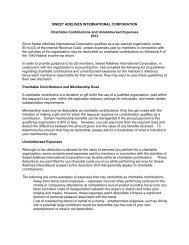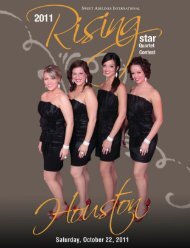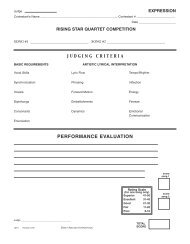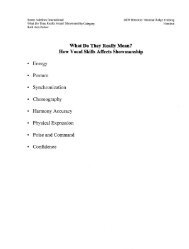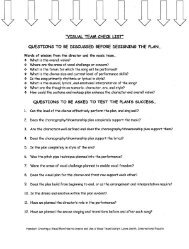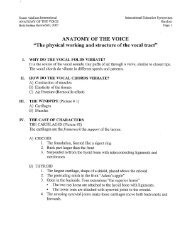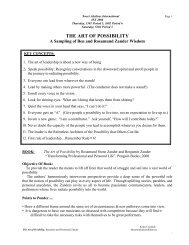PDF Image - Sweet Adelines International
PDF Image - Sweet Adelines International
PDF Image - Sweet Adelines International
Create successful ePaper yourself
Turn your PDF publications into a flip-book with our unique Google optimized e-Paper software.
<strong>Sweet</strong> <strong>Adelines</strong> <strong>International</strong><br />
FOUR ON THE FLOOR - THE WHOLE ENCHILADA<br />
Judy Pozsgay<br />
<strong>International</strong> Education Symposium<br />
Handout #1<br />
Page 2<br />
c. TRANSITIONS / TIMING AUDIENCE APPLAUSE<br />
• The "non-singing" palis ofyour performance - key is that you are still<br />
performing! Planning and rehearsing tius supports the professionalism ofyom<br />
performance.<br />
• Must keep the audience cOlmection/interest. Don't want them to use tills<br />
break in the music as time to leave to use the restroom!<br />
• Remember, you are still on stage and you are all visible! Do not adjust yom<br />
costume, scratch your face, etc. Maintain the energized posture, involved face<br />
and be attentive to what is happening.<br />
• Keep tlus fluid. Ifyou are between songs, move with purpose from one place<br />
to the next, and ensure your posture is confident and energized.<br />
• Applause Acceptance: Gauge yom audience while you are accepting applause<br />
alld begin to retreat back to the microphone (or leave the stage) when you feel<br />
the crest ofthe wave ofapplause. You do not wish to be standing in "applause<br />
acceptallCe" mode when the applause has started to wane; this leads to a gap<br />
in the flow and can create audience & performer discomfOli.<br />
• Setting the Mood: The trallsition period Call also contribute to your<br />
perfonnallce by creating the atmosphere/mood for your next song. Facial<br />
expression, body posture, speed and tillung can all assist the performer in<br />
preparing the audience for a ballad or uptune performallce. It can be janing to<br />
the audience ifa conflicting message is provided during the transition/set up<br />
ofthe next song.<br />
d. EMCEE<br />
• Not a class on emcee tecluuque, however the manner in which the speaker<br />
approaches the microphone and addresses the audience is definitely a part of<br />
the whole enchilada! Energy, postme and manner ofspeech Call maintain the<br />
audience cOlmection.<br />
• When addressing the audience, remember to vary the tone ofyour speech and<br />
look at the audience.<br />
• Practice good microphone tecluuque.<br />
• Plalvscript what you will say in advance and rehearse this! Plan for audience<br />
response (for eXalnple ifyou are hoping for laughter!) alld time accordingly.<br />
• Remember that you aloe there to enteliain the audience and keep them at ease.<br />
Do your best to know your audience demographic before a perfonnance and<br />
plan your material accordingly. Never include offensive or inappropriate<br />
material/subject matter in your script.<br />
• Non-speaking members are still in perfonnallce mode and should be attentive,<br />
engaged and energized while taking a "back seat" to the emcee. Pay attention<br />
to what is happening - you never know when sometillng might happen on<br />
stage and you might need to improvise! Ifyou don't appear interested in what



